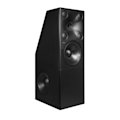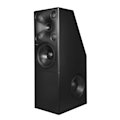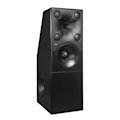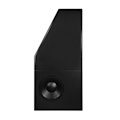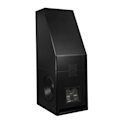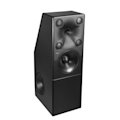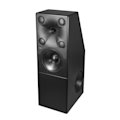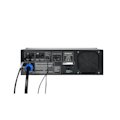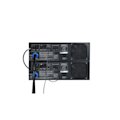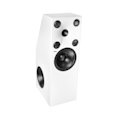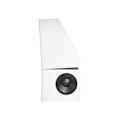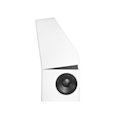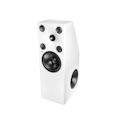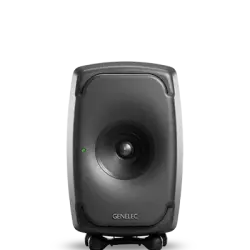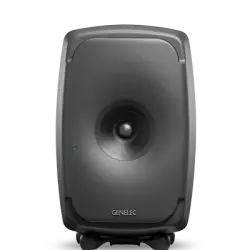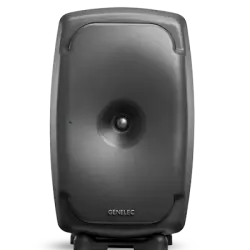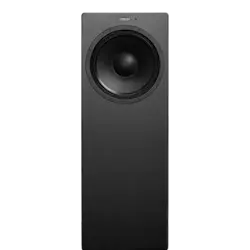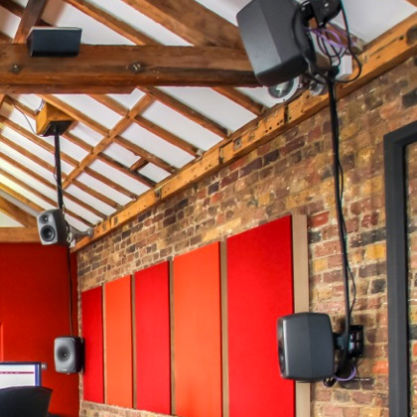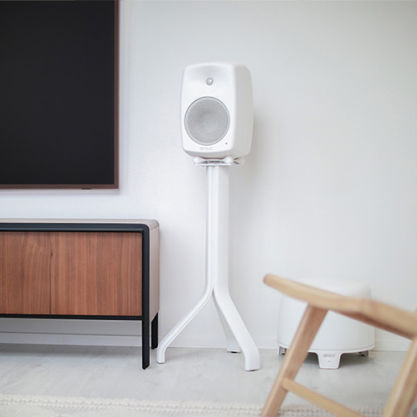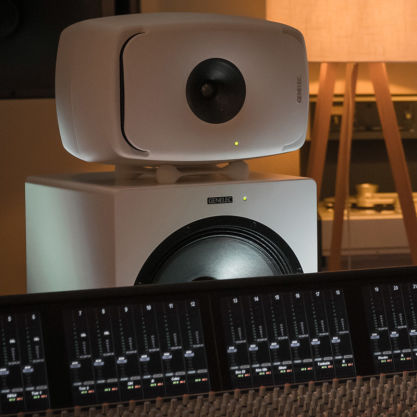Unser 8381A ermöglicht es Toningenieuren und Tonschaffenden, jedes klangliche Detail wahrzunehmen, und bietet hohe Schalldruckreserven und eine große Dynamik - mit der vollen Flexibilität einer freistehenden Lautsprecheraufstellung und fortschrittlicher Raumanpassung.
8381A
SAM™ Adaptiver Punktschallquellen-Hauptmonitor

Point Source Continued Directivity (PCD) Technology

Minimum Diffraction Coaxial (MDC™) Treiber-Technologie

SPL
126 dB

Frequenzgang
20 Hz - 35 kHz (-6 dB)

Abmessungen
H 1458 x W 500 x D 694 mm, (Anzeige in Inch)

Genau auf Ihren Raum zugeschnitten
Im Zusammenspiel mit unserer Genelec Loudspeaker Manager (GLM) Software passt sich das 8381A Monitoring System intelligent optimal an die akustischen Gegebenheiten das Abhörraums an. Dies ermöglicht größtmögliche Flexibilität selbst in schwierigen Hörumgebungen – und liefert eine hochpräzise Darstellung mit einer Tiefbasswiedergabe, die sich perfekt in den Gesamtsound integriert.
Der 8381A wurde so entwickelt, dass er den gesamten hörbaren Frequenzbereich wiedergibt, zeitrichtig abgestimmt und mit einem Frequenzgang, der über den normalen Hörbereich hinausgeht. Er liefert einen präzisen Einblick in alle noch so kleinen Details des aufgenommenen Materials. Mit seiner hohen Schalldruck-Kapazität und dem großen Dynamikumfang macht der 8381A auch sehr leise Signalanteile deutlich hörbar und wird somit zu einem einzigartigen und kompromisslosen Werkzeug für verlässliches Abhören.

Eine Abbildung, auf die Sie sich verlassen können
Treffen Sie schnell und sicher die richtigen Entscheidungen beim Mischen und Mastern durch eine kompromisslose Detailwiedergabe. Das Punktschallquellen-Prinzip des 8381A bietet den einzigartigen Vorteil, dass die präzise Klangfarbe und Abbildung in allen Hörentfernungen gleichbleibt. Das ermöglicht eine außergewöhnliche Freiheit bei der Wahl der Aufstellung und beseitigt die für größere Monitore typische vertikale Klangfarbenveränderung.
Die perfekt konstruierte Directivity Control Schallführung sorgt für eine saubere, verfärbungsfreie Wiedergabe. Sie reduziert den Einfluss des Nachhalls im Hörfeld und verbessert gleichzeitig die Genauigkeit und Zuverlässigkeit der Abhörsituation in allen Räumen.
Der 8381A ist ein Standlautsprecher und positioniert die Klangbühne in natürlicher Hörhöhe, während er mit dem mitgelieferten Neigungssystem auch traditionelle hohe Hauptmonitorpositionen unterstützt. So lässt sich die akustische Achse für alle Installationshöhen optimal auf die Hörposition ausrichten.

Eine neue Lösung, die Freiheit bietet
Die Innovationen des 8381A verschieben die Grenzen für freistehende Abhörlösungen. Er ist ein System, welches den Hörer in ein makelloses, naturgetreues Klangbild einhüllt.
Der Lautsprecher zeichnet sich dadurch aus, dass er die feinsten Details des Klangs durch die Kombination von enormer, kontrollierter Leistung mit punktgenauer Abbildungspräzision selbst in akustisch anspruchsvollen Abhörräumen klar zum Vorschein bringt.
Das Prinzip der Punktschallquelle in Kombination mit einer optimierten Richtcharakteristik erhält den ausgewogenen Frequenzgang auch außerhalb der Hauptachse und hilft dabei, den Klang selbst dann korrekt zu beurteilen, wenn man sich im Abhörraum bewegt, steht oder sitzt.

Genelec Qualität und Support
Der 8381A wurde mit Unterstützung des berühmten Industriedesigners Harri Koskinen entworfen und wird komplett in Iisalmi, Finnland, gefertigt.
Auf der Grundlage von mehr als vier Jahrzehnten Unternehmenserfahrung hat das passionierte Genelec-Ingenieurteam jede Komponente des 8381A sorgfältig entwickelt und optimiert. Auf diese Weise haben wir einen Monitoring-Lautsprecher geschaffen, der ideal für die anspruchsvollsten Anwendungen der Audiowelt geeignet ist - mit großen Leistungsreserven und kompromissloser Klangqualität.
Der 8381A ist für ein ganzes Leben voller Kreativität konzipiert. Daher erhalten Sie auch Zugang zu unseren einzigartigen Genelec SonicAdvisor™ Services. Wenn Sie also auf Ihrem Weg mit dem 8381A Unterstützung benötigen - von der Erstkonfiguration bis zur Beratung vor Ort - sind wir für Sie da.
8381A
Auszeichnungen

Genelec 8381A Adaptive Point Source Main Monitor has been chosen by Sound on Sound Magazine’s knowledgeable readership of audio professionals and enthusiasts as the winner of this year’s highly coveted SOS Best Studio Monitor Award.
Since 2010, Sound on Sound has sought the opinions of their huge worldwide following to decide the winners of a now iconic series of SOS Awards. Each year, the Awards' open online vote highlights the very finest new professional audio devices and software – helping audio lovers everywhere identify the year's best designs and innovations.

The 8381A Adaptive Point Source Main Smart Active Monitor is the recipient of a Technical Excellence & Creativity (TEC) Award at the 39th Annual TEC Awards, held on Saturday, January 27, at The 2024 NAMM Show in Anaheim, California. The 8381A got top honors in the Studio Monitors category. Finalists from all categories were selected by industry professionals across major music, sound, and game audio associations, along with pro audio focused media groups.
Presented annually by NAMM, the TEC Awards recognizes the individuals, companies and technical innovations behind the sound of recordings, live performances, films, television, video games and multimedia. Now in its 39th year, the Awards are widely recognized as the highest honor dedicated to the pro audio and sound recording industry.
Technische Spezifikationen

SPL
126 dB

Verstärkerleistung
2 X 5926 W Full range (Class D)

Frequenzgang
20 Hz - 35 kHz ("-6 dB")

Genauigkeit des Frequenzgangs
± 1.5 dB

Treiberabmessungen
2 x ⌀ 381 mm Bass + ⌀ 381 mm Bass + 4 x ⌀ 127 mm Midrange + ⌀ 127 mm Coaxial Midrange + ⌀ 25 mm Coaxial Tweeter (Anzeige in Inch)

Abmessungen
H 1458 x W 500 x D 694 mm, (Anzeige in Inch)

Gewicht
235 kg / 518.1 lb

Anschlüsse
2 x XLR Analog Input
2 x XLR Analog Output
2 x XLR AES/EBU Input
2 x XLR AES/EBU Output
4 x RJ45 Control
8381A
SAM™ Adaptiver Punktschallquellen-Hauptmonitor
Technische Spezifikationen
Unser 8381A ermöglicht es Toningenieuren und Tonschaffenden, jedes klangliche Detail wahrzunehmen, und bietet hohe Schalldruckreserven und eine große Dynamik - mit der vollen Flexibilität einer freistehenden Lautsprecheraufstellung und fortschrittlicher Raumanpassung.

Systemspezifikationen
Frequenzgang
(± 1.5 dB)
Low cutoff -6dB
20 Hz
High cutoff -6dB
35 kHz

SPL
Peak SPL Maximum output per pair.
≥129 dB
Kurzzeitiger max. SPL Mean SPL in range 100 Hz - 3 kHz,
≥126 dB
THD < 10 % f < 200 Hz, THD < 3 % f > 200 Hz
Short term sine wave, at 1 m, on axis, in half-space.
Max. Langzeit-SPL Maximum long term RMS acoustic output, IEC-weighted noise (limited by protection circuit) at 1 m, half-space.
≥121 dB
Eigenrauschen
Gewicht
Gewicht235 kg (518.1 lb)
Abmessungen
Höhe
1458 mm
Breite
500 mm
Tiefe
694 mm
Enclosure 1 dimensions: 880 x 694 x 500 mm Enclosure 2 dimensions: 570 x 694 x 500 mm Packing dimensions: 1076 x 1200 x 1000 mm
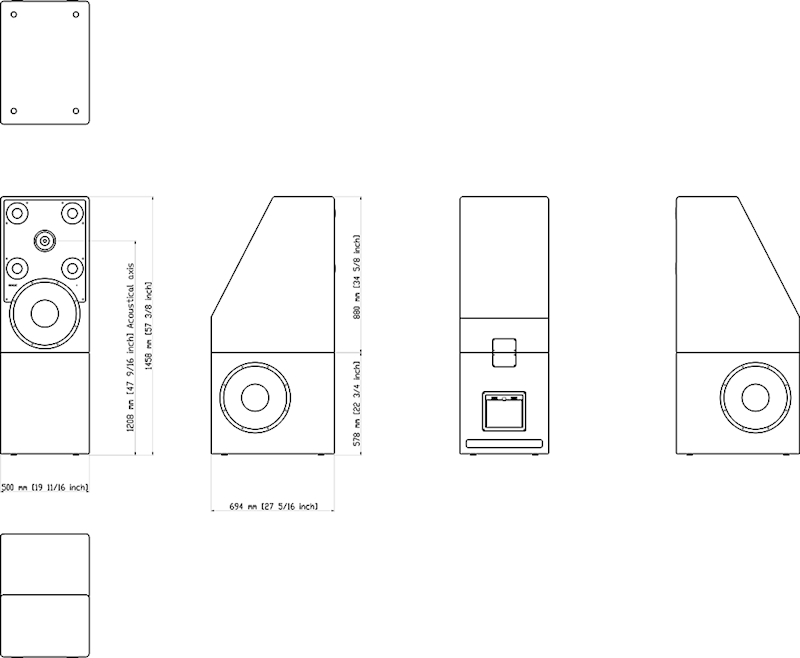
Gehäuse
Gehäusematerial
MDF
Treiber
Treiber-Typ
Cone
Double Low Woofers
Anzahl
2
Durchmesser
381 mm
Treiber-Typ
Cone
Front Woofer
Durchmesser
381 mm
Treiber-Typ
Dome
Quad Midrange System
Anzahl
4
Durchmesser
127 mm
Treiber-Typ
Cone
Coaxial Midrange
Durchmesser
127 mm
Treiber-Typ
Dome
Compression tweeter voice coil 25 mm (1 in), throat 13 mm (0.5 in)
Durchmesser
25 mm
Richtwirkung


Harmonische Verzerrung
Abschnitt Verstärker
Verstärker
2 x 5926 W Class D
2 X Class D amplifiers.
19 in rack mount, 3U high. Each amplifier is uniquely calibrated to a cabinet at Genelec factory in Iisalmi.
Total amplifier power is 5926 W.
Gewicht
11 kg
(24.3 lb)
Netzspannung
100-240 VAC 50/60Hz
Stromverbrauch
ISS aktiv
≤1.2 W
Leerlauf
≤140 W
Volle Leistung
2200 W
Abschnitt Signalverarbeitung
Anschlüsse
2 x Input Analog signal input connector XLR female, balanced 10 kOhm.
2 x Output XLR output connectors, 10 kOhm.
2 x Input Digital signal input connector XLR female 110 Ohm.
2 x Output Digital signal output / Thru connector XLR male 110 Ohm.
4 x Control Four CAT5 (RJ45) GLM Network connectors for computer control using the Genelec Loudspeaker Manager (GLM) software.
Crossover
Lower Woofer/Front Woofer
50-100 Hz (variable)
Front Woofer/Quad Midrange System
150-250 Hz (variable)
Quad Midrange System/Coaxial Midrange
500 Hz
Coaxial Midrange/Tweeter
1800 Hz
Produktvarianten
Produktcodes
Weitere technische Details finden Sie in der Anleitung.
Schlüsseltechnologien
Point Source Continued Directivity (PCD) Technology

Minimum Diffraction Coaxial (MDC™) Treiber-Technologie
Quad Midrange System (QMS)
Double Low-Woofer (DLW) System

Smart Active Monitor (SAM™)-Systeme

Bassreflexport-Design

Intelligent Signal Sensing (ISS™)-Technologie

Directivity Control Waveguide (DCW™)-Technologie

Optimierte Verstärker

Schutzschaltungen

Aktive Frequenzweichen
Point Source Continued Directivity (PCD) Technology
Important frequencies are experienced radiating from the same location and in perfect time alignment – creating precise sound imaging, natural soundstage presentation, and enabling the lowest frequencies to be reproduced at their intended source locations.
Der Minimum Diffraction Coaxial (MDC™)-Treiber ermöglicht herausragende Audiowiedergabe.

Typisch für alle aktuellen koaxialen Konstruktionen ist der etwas unruhige Frequenzgang aufgrund der inhärenten Beugungsprobleme. Crossover-Probleme, die durch die nicht-koinzidente Anordnung der Quellen entstehen, werden jedoch mit einer koaxialen Konfiguration gelöst. Hier liegt der Grundstein für die Minimum Diffraction Coaxial (MDC™)-Lösung von Genelec: Sie profitiert zwar von den typischen Vorteilen des koaxialen Designs, überwindet aber auch dessen gravierende Mängel.
Der erste Schritt besteht darin, die Auslenkung der Membran zu minimieren, d.h. die niederfrequente Bandbreite des Treibers zu begrenzen. Der nächste Schritt ist die Vermeidung aller Beugungsquellen. Die Hauptstruktur des MDC-Designs besteht aus einer integrierten MF-Membran-Suspension-Hochtöner-Konstruktion. Der sichtbare Teil des Koaxiallautsprechers besteht aus einer gebogenen, flexiblen Oberfläche, in deren Mitte sich die Hochtonkalotte befindet. Der innere Teil verbindet die Membran ohne akustische Unterbrechung mit dem Hochtöner, während der äußere Teil die Membran mit dem Treiberchassis verbindet.

Da es zwischen dem Hochtöner und der Membran keine akustisch wahrnehmbaren Diskontinuitäten gibt, sondern nur eine glatte Oberfläche, gibt es auch keine Beugung. Das Konusprofil ist sehr sorgfältig optimiert, um einen integrierten Richtcharakteristik-Schallführung für die Abstrahlung des Hochtöners zu bilden. Die Außenkante des Treibers ist mit einer normalen Genelec DCW-Schallführung abgeschlossen, um auch die Abstrahlung des Mitteltöners zu kontrollieren. Der Frequenzgang ist sowohl auf als auch außerhalb der Achse sehr gleichmäßig und frei von jeglichen Anomalien, und die Richtcharakteristik ist gut kontrolliert.
Dieser Durchbruch im koaxialen Design sorgt für eine verbesserte Abbildung und Gesamtklangqualität auf und außerhalb der Achse, einen extrem linearen Frequenzgang, der zu einer hervorragenden Klarheit und Definition aller Details von Audiosignalen führt.

Die wichtigsten Neuerungen der kombinierten DCW™- und MDC™-Designs von Genelec:
- Beugungsfreie Verbindung zwischen Hochton- und Mitteltonmembran
- Beugungsfreie Verbindung zwischen Mitteltonmembran und DCW™-Waveguide
- Eine proprietäre Technologie für die Mitteltonmembran - eine Laminatstruktur, die einen starren Konus und elastische Materialien einschließlich der Aufhängung kombiniert
- Eine Verbindung aus Mitteltonmembran und Aufhängung, die mögliche Nichtlinearitäten verhindert
Vorteile:
- Linearer Frequenzgang
- Sorgt für eine kohärente Kopplung der Treiber über ihre gesamte Betriebsbandbreite
- Erhebliche Verbesserung der Richtwirkung im kritischen Frequenzbereich
- Bietet eine ausgewogene Aufhängungsdynamik zur Minimierung akustischer Verzerrungen
- Optimiert die Nutzung der vorderen Schallwand des Gehäuses unter Beibehaltung des Aussehens und der Vorteile der 8000er-Serie
Quad Midrange System (QMS)
Acoustically coaxial woofer solution to support Minimum Diffraction Coaxial (MDC) driver output and maintain directivity in lower frequencies, enabling point source characteristics down into the woofer range.
Double Low-Woofer (DLW) System
Recoil-compensated adaptive low-woofer solution that combines with our Point Source Continued Directivity (PCD) Technology to give complete freedom of monitor placement in the room – with no compromise in performance or imaging detail.
Unsere vernetzten Smart Active Monitor (SAM™)-Systeme verfügen über eine automatische Anpassung an Ihre Hörumgebung.

In den letzten zehn Jahren hat die Erstellung von Medieninhalten weltweit rapide zugenommen, was zu erheblichen Veränderungen in der Art und Weise geführt hat, wie Einrichtungen mit der gestiegenen Arbeitsbelastung umgehen. Mehr denn je findet eine wachsende Zahl von Audioproduktionen in kleineren, engeren Arbeitsumgebungen statt. Dadurch verstärken sich häufig akustische Probleme und die Zuverlässigkeit beim Abhören sinkt. Gleichzeitig muss man sich als Profi auf ein präzises Abhörsystem verlassen können, das den Klang neutral und ohne Verfärbungen wiedergibt.
Aufbauend auf den bewährten elektroakustischen Grundlagen unserer Produkte der Serien 1200, 8000 und 7000 sind die fortschrittlichen SAM-Systeme von Genelec die modernsten und flexibelsten Abhörlösungen von heute. Sie sind ein unverzichtbares Werkzeug für Audioprofis, da sie sich automatisch an die akustische Umgebung anpassen und Pegel, Verzögerungen und Frequenzgang korrigieren können. SAM-Systeme können über das Genelec-eigene Loudspeaker Manager (GLM™)-Netzwerk und die entsprechende Software gesteuert werden, so dass Sie ein äußerst flexibles und zuverlässiges Abhörsystem aufbauen können.
Die GLM-Software ist ein intuitives und leistungsfähiges Monitorsteuerungs-Netzwerksystem, das die Verbindung zu allen SAM-Studiomonitoren und Subwoofern im Netzwerk verwaltet - mehr als 80 Geräte falls notwendig. Sie ermöglicht die Einstellung von Pegeln, Abstandsverzögerungen und eine Anpassung des Frequenzgangs mit dem intelligenten automatischen Kalibrierungsalgorithmus AutoCal™. Alle Parameter und Einstellungen werden in System-Setup-Dateien oder für den Stand Alone-Betrieb in jedem einzelnen Monitor oder Subwoofer gespeichert.
Außerdem können alle akustischen Eigenschaften der SAM-Systeme für verschiedene Arbeitsstile oder Kundenanforderungen optimiert werden. Auch ween Sie zwischen verschiedenen Räumen wechseln, können Sie von der SAM-Technologie profitieren und ein Höchstmaß an Konsistenz beim Monitoring erreichen.
Genelec SAM-Systeme bieten eine umfassend skalierbare, lösungsorientierte, intelligent vernetzte Produktpalette, die analoge und digitale Signale in praktisch jeder Arbeitsumgebung unterstützt.
Spezielles Bassreflexport-Design für erweiterten Frequenzgang im Bassbereich.

Genelecs Entscheidung für Bassreflex-Gehäuse geht auf das Modell S30 zurück, das erste Genelec-Produkt aus dem Jahr 1978. Die Leistung der Ports wurde im Laufe der Jahre verbessert und verfeinert, um die Basserweiterung und den Schalldruckpegel des Tieftöners zu erhöhen und eine hervorragende Bassartikulation und -definition zu erreichen.
Sowohl der Treiber als auch der Port tragen zur Gesamtabstrahlung eines Reflexgehäuses bei. Der größte Teil der Abstrahlung kommt vom Treiber, aber bei der Resonanzfrequenz des Bassreflexgehäuses ist die Auslenkungsamplitude des Treibers klein und der größte Teil der Abstrahlung kommt aus der Öffnung.
Um die Luftgeschwindigkeit im Rohr zu minimieren, sollte die Querschnittsfläche der Öffnung groß sein. Das wiederum bedeutet, dass das Reflexrohr lang sein muss, was eine ziemliche Herausforderung für das Design darstellt.
Das lange, gebogene Rohr maximiert den Luftstrom, so dass tiefe Bässe ohne Kompression wiedergegeben werden können. Aus offensichtlichen Gründen endet das Reflexrohr in einer weiten Ausbuchtung auf der Rückseite des Gehäuses, wodurch Öffnungsgeräusche minimiert werden und eine hervorragende Bassartikulation gewährleistet wird.
Die Krümmung des Rohrs wurde ebenfalls sorgfältig entwickelt, um hörbare Geräusche, Kompression oder Verzerrungen zu minimieren. Das innere Ende des Rohrs hat einen geeigneten Widerstandsabschluss, um wiederum hörbare Rauschgeräusche und Luftverwirbelungen zu minimieren.
Das Design der Reflexöffnungen ermöglicht es, die Auslenkung des Tieftöners erheblich zu reduzieren und die lineare Tieftonleistung zu verbessern.
Intelligent Signal Sensing (ISS™) zur Reduzierung des Stromverbrauchs und automatische Nutzung des Standby-Modus.

Die Anfang 2013 eingeführte Intelligent Signal-Sensing-Technologie von Genelec wurde entwickelt, um sowohl die ErP-Richtlinien der Europäischen Union als auch die umfassenderen Nachhaltigkeitsverpflichtungen des Unternehmens zu erfüllen.
Die Intelligent Signal Sensing, ISS™-Schaltung verfolgt den Signaleingang des Lautsprechers und erkennt, ob er genutzt wird. Wenn der ISS-Schaltkreis über einen bestimmten Zeitraum kein Audiosignal am Eingang findet, versetzt er den Lautsprecher in einen energiesparenden Ruhezustand und der Lautsprecher verbraucht weniger als 0,5 Watt. Wenn ein Eingangssignal erkannt wird, schaltet sich der Lautsprecher sofort wieder ein.
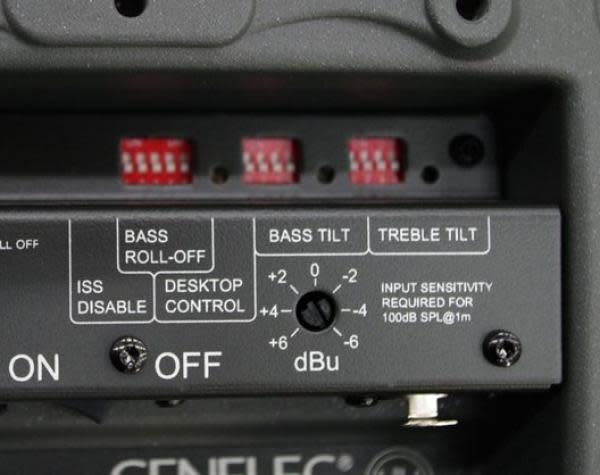
Wenn diese Funktion nicht genutzt werden soll, kann ISS™ deaktiviert werden, indem der DIP-Schalter "ISS Disable" auf der Rückseite in die Position "ON" gestellt wird. In diesem Modus wird der Monitor nur über den Netzschalter ein- und ausgeschaltet.
Beachten Sie, dass der Netzschalter den Monitor immer vollständig ausschaltet.
Nachfolgend finden Sie eine Liste der Bedingungen, die verhindern, dass der Monitor oder Subwoofer in den ISS-Ruhezustand versetzt wird:
- Am Analogeingang wird ein Signal erkannt.
- Am Digitaleingang wird ein Signal erkannt. Das kann auch das Clocking-Signal Ihrer Quelle sein, das auch anliegt, wenn kein Audio wiedergegeben wird.
- Das GLM-Netzwerk ist aktiv und GLM läuft. GLM 5 bietet eine eigene ISS Funktion an.
- ISS ist deaktiviert.
Es ist üblich, dass digitale Audioquellen das Clocking-Signal senden, sobald die Quelle eingeschaltet ist. Dies verhindert, dass der Monitor oder Subwoofer in den Ruhezustand übergeht. Es könnte auch ein Rauschen im analogen Eingangssignal vorhanden sein, das den Ruhezustand von ISS verhindert. Um herauszufinden, an welchem Eingang ein Signal anliegt, das das Umschalten in den ISS-Ruhezustand verhindert, entfernen Sie jedes Kabel einzeln und prüfen Sie, ob der ISS-Ruhezustand aktiviert wird.
Directivity Control Waveguide (DCW™)-Schallführung für ausgewogene Abstrahlung auf und außerhalb der Hörachse.

Mit der Entwicklung der Directivity Control Waveguide (DCW™)-Schallführung verfolgte Genelec 1983 einen revolutionären Ansatz. Sie wurde damals in einem eiförmigen Gehäuse eingesetzt. Über 30 Jahre entwickelt und immer weiter verfeinert, verbessert sie die Leistung von direkt abstrahlenden Mehrwege-Monitoren erheblich.
Die DCW-Technologie formt die abgestrahlte Wellenfront auf kontrollierte Weise und ermöglicht so eine vorhersehbare Anpassung des Abstrahlverhaltens (Dispersion). Um eine gleichmäßige und ausgewogene Richtcharakteristik zu erreichen, wird der Abstrahlwinkel begrenzt, so dass die Streustrahlung reduziert wird. Dies führt zu einer ausgezeichneten Linearität des gesamten Frequenzgangs sowie zu einem gleichmäßigen Leistungsverhalten. Frühe Reflexionen werden minimiert und man erreicht eine breite und kontrollierte Hörzone, mit einer akkuraten Klangwiedergabe auf und außerhalb der Achse.
Geringe Erstreflexionen und eine kontrollierte, konstante Richtwirkung haben einen weiteren wichtigen Vorteil: Die Frequenzbalance des Raumschallfeldes ist im Wesentlichen die gleiche wie die des Direktfeldes der Monitore. Das hat zur Folge, dass die Leistung des Abhörsystems weniger von den raumakustischen Eigenschaften abhängig ist.
Breite und Tiefe des Klangbildes, kritische Komponenten in jeder Hörumgebung, sind nicht nur für das Hören auf der Achse, sondern auch außerhalb der Achse wichtig. Davon profitieren auch anderen Personen im Raum, die nicht im Sweet Spot sitzen, wie es in großen Regieräumen oft der Fall ist.
DCW™-Technologie Hauptvorteile:
- Lineare On- und Off-Axis-Wiedergabe für einen größeren nutzbaren Hörbereich
- Erhöhtes Verhältnis von Direkt- zu Reflexionsschall für eine geringere Verfärbung durch den Abhörraum
- Verbesserte Stereoabbildung und Tiefenstaffelung
- Erhöhte Empfindlichkeit der Antriebseinheit um bis zu 6 dB
- Erhöhte Kapazität des maximalen Schalldruckpegels des Systems
- Geringere Verzerrung des Chassis
- Geringere Beugung an den Gehäusekanten
- Geringere Verzerrung des gesamten Systems
Jeder Treiber wird von einem eigenen, optimierten Verstärker angesteuert.

Elektronische Frequenzweichen ermöglichen es, das Audiosignal in einzelne Frequenzbänder aufzuteilen, die separat an einzelne Leistungsverstärker geleitet werden können, die dann an spezielle, für ein bestimmtes Frequenzband optimierte Schallwandler angeschlossen werden.
In einem typischen 2-Wege-Lautsprechersystem benötigt die aktive Frequenzweiche zwei Leistungsverstärker - einen für den Tieftöner und einen für den Hochtöner. Die Leistungsverstärker werden direkt an die Chassis eines Aktivlautsprechers angeschlossen, wodurch die Belastung des Leistungsverstärkers viel einfacher ermittelt werden kann. Jeder treiberspezifische Leistungsverstärker hat nur einen begrenzten Frequenzbereich zu verstärken (der Leistungsverstärker wird nach der aktiven Frequenzweiche platziert), was die Konstruktion noch einfacher macht.
Das Aktivprinzip bietet mehrere Vorteile:
- Die Leistungsverstärker sind direkt mit den Lautsprechertreibern verbunden, wodurch die Kontrolle durch die Dämpfung des Leistungsverstärkers auf die Schwingspule des Treibers maximiert und die Folgen dynamischer Änderungen der elektrischen Eigenschaften des Treibers verringert werden. Dies kann das Einschwingverhalten des Systems verbessern.
- Der Leistungsbedarf des Endverstärkers ist geringer. Da in den passiven Frequenzweichen-Filterkomponenten keine Energie verloren geht, wird die erforderliche Verstärkerleistung erheblich reduziert (in einigen Fällen um bis zu 50%), ohne dass die akustische Leistung des Lautsprechersystems verringert wird. Dadurch können Kosten gesenkt und die Audioqualität und Zuverlässigkeit des Systems erhöht werden.
- Kein Verlust zwischen Verstärker und Treibereinheiten führt zu einer maximalen akustischen Effizienz
- Mit aktiver Technologie kann eine überragende Klangleistung im Verhältnis zur Größe und zur Leistung bei niedrigen Frequenzen erzielt werden
- Alle Lautsprecher werden als werkseitig aufeinander abgestimmtes System geliefert (Verstärker, Frequenzweichen-Elektronik und Gehäuse-Treiber-Systeme)
Hochentwickelte Schutzschaltungen für die Treiber garantieren einen sicheren Betrieb.
In kritischen Produktionsumgebungen ist es unerlässlich, dass Abhörsysteme jederzeit zuverlässig und voll funktionsfähig arbeiten. Einer der Hauptgründe für den großen Erfolg von Genelec in Rundfunk- und Fernsehumgebungen ist die Zuverlässigkeit unserer Produkte. Ein Schlüsselelement für diese Zuverlässigkeit ist die interne Schutzschaltung, die seit 1978 in allen Produkten enthalten ist.
Die Schutzschaltung verhindert Treiberausfälle, indem sie Signalpegel erkennt und bei plötzlichen Pegelspitzen oder konstant zu hohen Pegeln den Signalpegel automatisch absenkt. Natürlich beeinträchtigt diese Funktion in keiner Weise die Klangqualität der Lautsprecher, wenn sie innerhalb der Spezifikationen arbeiten, sondern verhindert nur, dass zu hohe Eingangssignale den Lautsprecher zerstören.
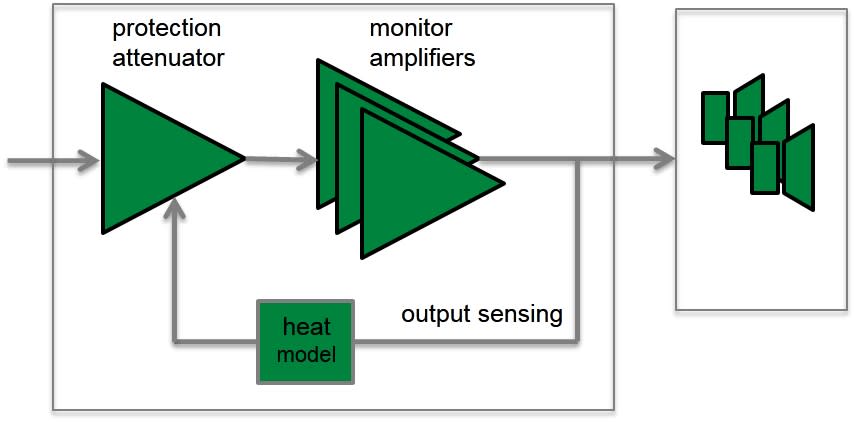
Merkmale und Vorteile der Schutzschaltungen:
- Reduziert den Ausgangspegel bei Bedarf (z. B. wenn die Temperatur der Schwingspule des Treibers den sicheren Grenzwert erreicht), was die Zuverlässigkeit des Systems erheblich verbessert
- Geeignete Schutzschaltungen in allen Lautsprechern und Subwoofern ermöglichen eine Maximierung des Systemausgangsschallpegels.
Aktive Frequenzweichen, die mit niedrigen Signalpegeln arbeiten.

Elektronische Frequenzweichen ermöglichen die Aufteilung des Audiosignals in einzelne Frequenzbänder, die separat an einzelne Leistungsverstärker geleitet werden können, die dann an spezifische, für ein bestimmtes Frequenzband optimierte Wandler angeschlossen werden.
Aktive Frequenzweichen gibt es sowohl in digitaler als auch in analoger Ausführung. Die digitalen aktiven Frequenzweichen von Genelec beinhalten zusätzliche Signalverarbeitung wie Schutzschaltungen, Verzögerung und Entzerrung.
Analoge aktive Frequenzweichen von Genelec enthalten elektronische Komponenten, die mit niedrigen Signalpegeln betrieben werden, die für die Eingänge von Leistungsverstärkern geeignet sind. Dies steht im Gegensatz zu passiven Frequenzweichen, die mit den hohen Signalpegeln der Endverstärkerausgänge arbeiten und dabei hohe Ströme und in einigen Fällen auch hohe Spannungen verarbeiten müssen.
In einem typischen 2-Wege-System benötigt die aktive Frequenzweiche zwei Leistungsverstärker - einen für den Tieftöner und einen für den Hochtöner.
Das Design der aktiven Frequenzweiche bietet mehrere Vorteile:
- Der Frequenzgang wird unabhängig von dynamischen Änderungen der elektrischen Eigenschaften des Treibers oder des Treiberpegels.
- Es besteht eine erhöhte Flexibilität und Präzision bei der Einstellung und Feinabstimmung jedes Ausgangsfrequenzgangs für die verwendeten Treiber.
- Jeder Treiber hat seine eigene Signalverarbeitung und seinen eigenen Leistungsverstärker. Dadurch wird jeder Treiber von den Treibersignalen der anderen Treiber isoliert, was Intermodulationsverzerrungen und Übersteuerungsprobleme reduziert.
- Empfindlichkeitsschwankungen zwischen den Treibern können kompensiert werden.
- Frequenz- und Phasenganganomalien, die mit den Eigenschaften eines Treibers innerhalb des vorgesehenen Durchlassbereichs verbunden sind, können kompensiert werden.
- Der neutrale Frequenzgang eines hochwertigen Aktivlautsprechers ist das Ergebnis der kombinierten Wirkung des Frequenzweichenfilters, des Leistungsverstärkers und der Treiber in einem Lautsprechergehäuse.
Die Verwendung des aktiven Ansatzes ermöglicht die Anpassung und Optimierung des Frequenzgangs des gesamten Lautsprechersystems in verschiedenen Raumumgebungen ohne teure externe Equalizer. Das Endergebnis ist ein einfacheres, zuverlässigeres, effizienteres, konsistenteres und präziseres aktives Lautsprechersystem.
Referenzen
Genelec UNIO Explained | How the ecosystem offers seamless in-room and personal headphone monitoring
Introducing The Main Ones | Our new 8381A Adaptive Point Source Main Monitor
Genelec 8381A | Launch and overview of our new Adaptive Point Source Main Monitor
Genelec UNIO Explained | How the ecosystem offers seamless in-room and personal headphone monitoring
A quick guide to our UNIO Ecosystem – which offers audio engineers seamless bridging of in-room and personal headphone monitoring. https://genelec.com/UNIO
The Genelec UNIO Ecosystem – which combines the power of our renowned GLM, SAM Monitoring and Aural ID adaptive technologies – gives audio engineers the flexibility to work anywhere, anytime, from stereo to immersive. And now, with the new UNIO Personal Reference Monitoring (PRM) solution, audio professionals benefit from the pinpoint accuracy of our pioneering active monitoring headphone solution, which combines the 9320A SAM Reference Controller with uniquely factory-calibrated 8550A Professional Reference Headphones.
To learn more, visit https://genelec.com/UNIO
Introducing The Main Ones | Our new 8381A Adaptive Point Source Main Monitor
Liberate the way you listen in your space with immaculate imaging both on and off-axis, near or far, thanks to point source characteristics that extend below midrange and advanced room adaption from our Smart Active Monitoring (SAM) Technology and Genelec Loudspeaker Manager (GLM) software.
Keep all the benefits of free-standing monitor placement, for a simple, zero-hassle installation. The 8381A is main monitoring as you’ve never known it before. Ideal for high sound pressure level applications in medium to large control rooms in professional recording, mixing and mastering studios, and for the most demanding high-fidelity listening applications.
Genelec 8381A | Launch and overview of our new Adaptive Point Source Main Monitor
Perceive every sonic detail with the new Genelec 8381A Adaptive Point Source Main Monitor, offering true-to-life sound level and dynamics and an ultra-wide full-range response. Liberate the way you listen in your space with immaculate imaging both on and off-axis, near or far, thanks to point source characteristics that extend below midrange and advanced room adaption from our Smart Active Monitoring (SAM) Technology and Genelec Loudspeaker Manager (GLM) software.
Händler finden













